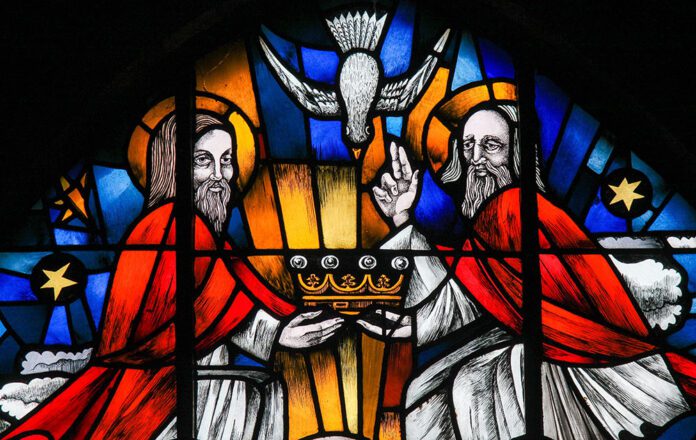When speaking of the Trinity, it is very easy to enter into heresy. This is why we must be meticulous in our study in Theology. Detail matters; especially when it comes to God. As I move forward, I desire to keep this simple to avoid speaking incorrectly. All analogies used, will fall short. There is nothing that compares to God. But for the sake of learning, analogies are helpful. It is completely acceptable not to understand, because as St. Augustine famously said, “If you think you have grasped him, it is not God you have grasped.”
All people are called by God to have a relationship with Him. We are created out of His plan of sheer goodness to give His life to us. Our hearts are restless until they find rest in Him as St. Augustine tells us. We can know through reason and observation, that God exists. Yet, due to our human nature, we cannot come to know everything about God. Even of the things that we can know, our sinful nature obscures our reason. God knows this, and has to reveal himself to us through Divine Revelation for our good. As a result, we have come to know our Trinitarian God through the inner communion of the Trinity and Its relationship with us.
As Catholic grade school or CCD may have taught us, God is three persons in one God. Yet, because it can be so intimidating, it is rare that you find catechists willing to explain deeper than the St. Patrick three leaf clover. We will not go into Latin or Greek, but we can dive deeper than the famous analogy.
The three persons of the Father, Son, and Holy Spirit all have the same essence as God. Yet to understand Him further, God allows us to get a glimpse of His interior communion. The Father is the only person of the Trinity that does not have origin. He is known as the Creator and is eternal with no beginning or end. The Son is begotten by the Father, yet this has been as long as the Father has been in existence. We must not think that the Father created the Son. Rather, He comes forth from the Father from the same eternal essence, but as a different person. This means we ought not think that there was a time when the Father was and the Son was not. The Holy Spirit comes forth from the Father and the Son and is given to humanity to sustain the Body of Christ, the Church. Just as the Son, the Spirit is not created, but eternally given by the Father and the Son for all time.
If it is helpful, the Holy Trinity can be viewed through the analogous lens of the traditional family. The father and the mother of a family are two persons who give glory to each other through loving sacrifice and are one family. From their self-giving love, comes children whose genetic and social features point back to the parents. In the perfect scenario, the parents love and sacrifice for their children while the children’s behavior in the world gives life and glory to those who they came from. In a similar way, the love of the Father and the Son allows the Spirit to proceed from Them and give life to all it encounters. All glory gained by the actions of the Spirit is given back to the Father and the Son. Just as the family is held together by love, so is the Trinity who is Love (1 John 4:8). It must be noted that this analogy falls short because no human family is eternal or perfect in love. Also while God’s love is self giving, we must not be tempted to think that it is in any way sexual.
Yet out of pure love for us, God created us to enter into this Trintarian communion of Love. Thus, we see the action of the Trinity over the course of human history. So not only do we have a glimpse of how the Trinity relates to each other, we can also identify how the Trinity relates to us. The Father is the creator, the one from whom life comes. When He communicates or creates, He does so through His Word, who is His Son. The universe was created when God the Father spoke His Word. Both the Creator and the Word send forth the Spirit who gives life to creation, including humans, and God was present with man in creation.
Yet, creation fell through man’s sin. The perfection of creation was disordered by humans grasping to be like God. As a result, God and humans were separated by sin. Yet God never stopped loving His creation. He continued to speak His Word in varied, incomplete ways and gave His Spirit to those who humbled themselves before Him. This continued until He sent the Word Incarnate, His Son, into the world in the person of Jesus Christ who redeemed the world through His teaching, preaching, suffering, death, resurrection, and ascension into Heaven. He was the complete revelation of God the Father to humans spoken in one Word becoming flesh. The Word tore His flesh in His passion in which we pass through to enter into the Holy of Holies of communion with the Trinity in heaven (Hebrews 10:20). The message of Jesus and the graces provided for the world through His suffering, death, and resurrection are transmitted and passed down to all generations through the guidance of the Holy Spirit, who is continually revealing to us the depths of God’s spoken Word of Love to the world in the person of Jesus Christ.
Through their work in salvation history, we know the Father, Son, and Holy Spirit as the Creator, Redeemer, and Sanctifier. Yet, we have yet to understand the fullness of God’s revelation to us. As human history continues until the Second Coming of Jesus, we must “work out your salvation with fear and trembling” (Philippians 2: 12) in the joyful hope that “we are God’s children now; what we shall be has not yet been revealed. We do know that when it is revealed we shall be like him, for we shall see him as he is” (1 John 3:2).


